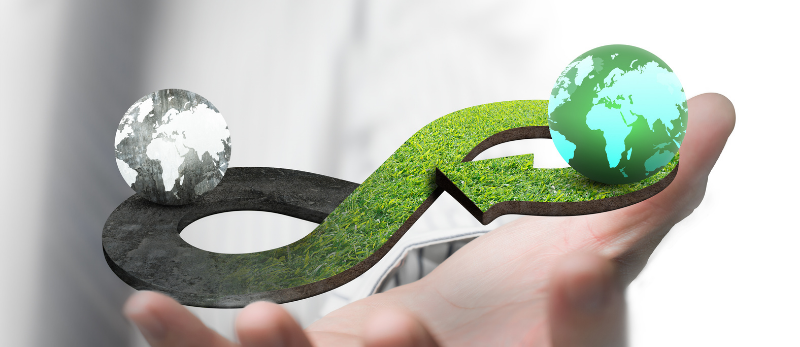Please welcome Sara Lashari, a devoted volunteer of Sustainability Leadership, who is our guest blogger for this month’s post on Investing in a Circular Economy.
What is the Circular Economy?
It is an approach that aims to redefine economic development by moving away from the prevalent ‘take-make-dispose’ linear economic model to one where materials can be reused, remanufactured, and recycled, i.e., remain in circulation for as long as possible.

So, is This the Same as Recycling?
Recycling is a process that converts waste into materials that can be reused in a product lifecycle; it is one measure of pollution control.
Circular Economy, however, is a systemic approach that changes the product lifecycle so that fewer resources are used from the outset, less waste is produced at the end, and fewer GHG emissions are emitted during the production process. This approach changes our economic growth model into one that values raw materials and one that shifts away from frequently replacing and discarding products that end up in landfill.
Why Now?
This is a critical issue facing our society as we see the effects of the climate crisis in our everyday lives. Our linear economy produces the GHG emissions contributing directly to climate change, due to its hefty reliance on fossil fuels and non-renewable resources. If we focus our efforts only on emissions reduction, and the transition to renewable energy, research shows that we would only address 55% of emissions – the remaining come from our linear economy. Hence, to achieve zero emissions by 2050 and to meet the 1.5C target of the Paris Agreement, a fundamental shift in our production systems is needed.
Main Principles of a Circular Economy
According to the MacArthur Foundation, there are 3 main areas of focus to change the way we manufacture our products:
- Design out and eliminate waste
- Reuse materials and products
- Regeneration for natural systems
Let’s zoom in and briefly describe these approaches:
Design out and eliminate waste: This requires new and innovative ways of designing products to eliminate waste right at the source. Over the short term, this effort also includes finding ways to use the waste from existing end-of-life products, extract the resources from them to reintroduce in the production cycle. The goal over the long term will be to design out or minimize waste as much as possible from product inception, i.e., cradle to cradle design.
Reuse Materials: The main purpose here is that the product still has valuable resources (materials, labour, cost of production) and by reutilizing it, we are conserving the GHG emissions that would be associated with its end-of-life disposal and the production of any new materials. One way to do that is to rethink product ownership and consider just having access to the product (e.g., renting, leasing etc.). There are many familiar examples where such models are already applied, e.g., libraries, car rental services or leasing cars. Since producers retain ownership of the items, it also incentivizes them to find innovative solutions in the design of durable products. Where products are sold, there should be models in place for return and reuse of either the product or its components/parts.
Regeneration for Natural Systems:
The linear economy uses natural resources into goods and products, which once utilized, are turned into waste, and disposed of. To have a positive impact on our environment, we need regenerative models that minimize extraction of nonrenewable resources, pollute less, find ways to recover nutrients and safely feed them back into the environment. When you think of nature, there exists a closed loop with no concept of waste. Circular economy aims to imitate our natural cycles so that economic activity can protect the environment. This implies circular supply chains and business practices that intersect. As one example, Interface, one the world’s leading modular carpet manufacturer, introduced their “Factory as a Forest” project in Australia. The idea, in theory, is for this factory to provide ecosystem services like clean air, energy, carbon sequestration etc. that its forest ecosystem would have provided.
Main Principles of a Circular Economy
To implement the above approaches, we need to shift towards innovative business models and establish cross-sector partnerships to implement them. The move to a circular economy is not an effort that can be achieved in silo’s, it requires extensive stakeholder collaboration across academia, non-profit, social, private, and public sectors. A recent example of such cross-sector partnership is the New Plastic Economy Initiative – led by the Ellen MacArthur Foundation., which has mobilized a shift towards plastic circularity by engaging leading companies, academics, municipalities, philanthropists, policy makers and other key stakeholder groups.
Role of Academia
Working in Higher Ed., I find myself hard pressed not to highlight the crucial role of academia in this effort. Let’s take the example of Quebec’s circular economy efforts and how the region engaged its academics right from the outset.
A new university-based institution (EDDEC) was created with the mission to promote interdisciplinary research, develop tools and resources, and mobilize public and private sector decision-makers in actioning strategies for a circular economy. You can read more about Quebec’s transition and key lessons learned here. Some key takeaways were:
- Building a Community of Practice (CoP) – engaging with like-minded practitioners nationally and internationally – to obtain new knowledge and best practices in this arena was instrumental in creating a knowledge baseline, raising awareness, and engaging innovators in circular economy within the region.
- Creation of a pilot research program in consultation with non-academic corporations. This spawned several other research projects, which provided opportunities for graduate students to collaborate and participate in those initiatives. These strategies, in combination, further strengthened the CoP.
- Creation of an online open-source course which is applicable to students, professionals in private and public sectors.
All the above highlight how one of the key steps in this journey is raising awareness about this model and bringing experts together to inform a bottom-up approach in the development of a circular economy strategy.
Creating Systems Change
Transformational change is a journey, not a destination. When our entire economy is built on a linear model, no one actor can produce the shift that is needed. A systemic change is required; huge investments in infrastructure, product design, and public policy incentivizing businesses to adopt circular business models, research and innovation to scale solutions at the commercial level is needed to create that shift. The UK’s current Plastic Packaging Tax is one such example. As of April 2022, it will be applicable to all plastic packaging that does not contain at least 30% recycled plastic, whether produced in the UK or imported. As consumers become aware of sustainability and more governments introduce relevant legislation, businesses that are early adopters will gain a competitive advantage and reap the financial benefits as well.
Critical to all this stakeholder engagement is communication. Developing targeted and specific communications based on industry/sector is key, as is using the right channels to connect to target audiences. Such outreach not only allows for capacity building, but also brings civil society into the dialogue and can create a regional momentum (as in the case of Québec). Communicating results of any pilot initiatives undertaken by businesses in circular economy will result in creating connections between those early adopters and other interested stakeholder groups leading to more tangible projects and joint partnerships.
Looking Ahead
The Circular economy model provides solutions to the climate crisis, the culture of overconsumption, and waste production. Incidentally, this September Canada is co-hosting the 2021 Word Circular Economy Forum (WCEF) – established in 2017 – with Finland, marking this as the first time this global conference has been hosted in North America. Finland is the first country in the world to create a national roadmap for transitioning to a circular economy and the measures outlined by the country have been accepted by its business corporations and municipalities. This roadmap is a framework for countries looking to transition to a circular economy – a topic that is important given the upcoming 2021 federal election. I am hopeful for the future, and we need to continue to engage all stakeholders in our society to examine our current systems and policies as we continue this journey.


